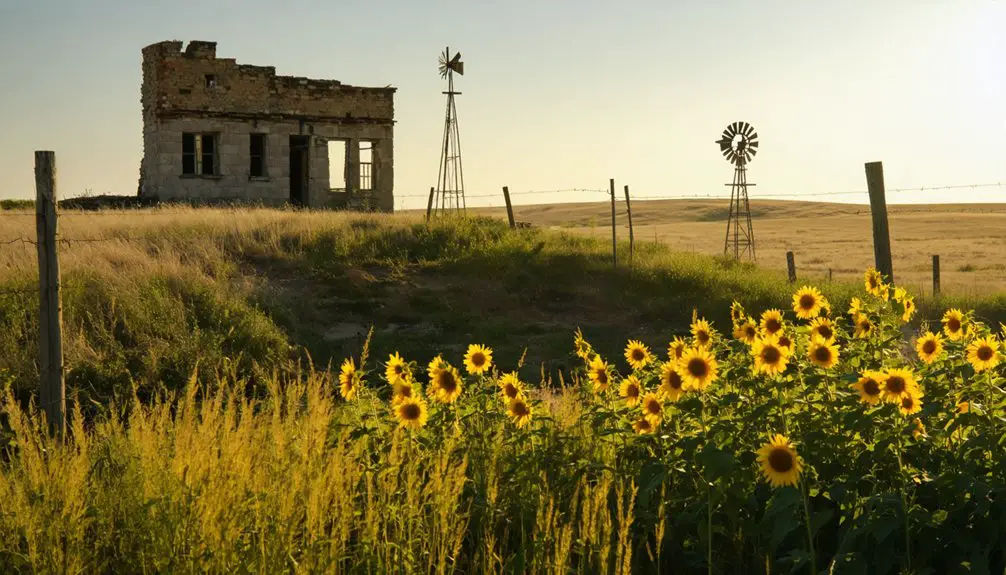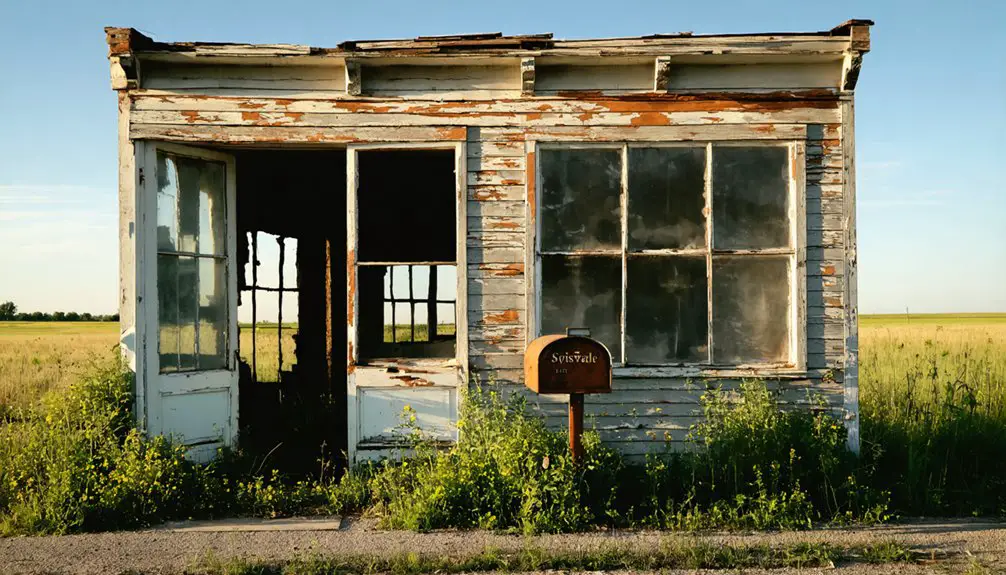You’ll find Swissvale’s remains at the intersection of 129th and Paulen Roads in eastern Kansas, where a once-bustling mining community thrived in the late 1800s. The town grew around coal mining operations, with Swiss immigrants establishing a vibrant community complete with stores, hotels, and schools. After the mining industry declined in the 1930s, residents gradually left, and the last school closed in 1964. Today, fewer than five occupied homes stand among the weathered foundations and overgrown railroad tracks, each telling a piece of Kansas’s rich mining heritage.
Key Takeaways
- Swissvale was a Kansas mining town located at 129th and Paulen Roads that became abandoned after mining operations declined.
- The town peaked at 600 residents during early 1900s coal mining operations before economic hardships led to its abandonment.
- Only remnants remain today: fewer than five occupied homes, boarded commercial buildings, and a crumbling brick high school.
- The Missouri Pacific Railroad tracks still mark the landscape, but original buildings have largely disappeared beneath vegetation.
- Historical foundations and the Ridgeway Cemetery with Civil War-era headstones preserve the ghost town’s cultural legacy.
The Rise and Fall of a Kansas Mining Town
When coal deposits were discovered in late 19th century Kansas, Swissvale emerged as one of many mining communities that would shape the region’s industrial landscape. Located in Crawford County, coal mining operations here were part of the extensive Cherokee shales that dominated southeastern Kansas.
The town’s mining heritage flourished as workers and their families settled in, pushing the area’s population to nearly 90,000 by 1920. You’d find miners equipped with their own tools and carbide lamps, working in dangerous conditions underground while supporting a bustling local economy. The state recognized the dangers of mining and established rules in 1883 that prohibited young boys from entering the mines.
The community’s resilience was tested as surface mining gained prominence in the 1930s. The arrival of massive machinery like Big Brutus signaled the end of traditional shaft mining.
Location and Historical Context
Nestled at the intersection of modern 129th and Paulen Roads in eastern Kansas, Swissvale once stood as a proof of the region’s railroad-driven settlement boom of the late 1800s.
In eastern Kansas, a ghost town called Swissvale marks where railroad expansion once sparked frontier settlement and growth.
You’ll find this ghost town‘s geographic coordinates at approximately 38.6° N latitude and 94.8° W longitude, situated in the gently rolling terrain of the Great Plains.
Before European settlers arrived, nomadic Native American tribes called this land home for thousands of years, as evidenced by archaeological discoveries from major digs conducted in the 1930s.
When railroads expanded across Kansas in the 19th century, Swissvale emerged alongside similar communities like Kennekuk, Keokuk, and Waldeck.
Much like how Count Wolrad I helped establish the Waldeck region in Germany during the 1400s, these Kansas settlements were vital in establishing the state’s early infrastructure.
The town thrived briefly but couldn’t survive the changing economic landscape.
Economic Landscape and Decline
As you explore Swissvale’s economic decline, you’ll find that the limestone quarry’s closure in the late 1800s dealt the town its most significant blow, mirroring challenges faced by other Kansas mining communities of that era.
The town’s agricultural activities couldn’t sustain the local economy on their own, especially as railroad traffic diminished and market access became increasingly limited. Similar to Bigelow’s limestone quarrying, this industry’s demise marked a turning point for local employment and commerce.
This economic downturn triggered a steady population exodus, with residents relocating to more prosperous communities that offered greater employment opportunities and stronger economic foundations. The shift paralleled the fate of towns like Minersville, where market changes forced entire communities to abandon their mining-focused economies.
Mining Industry Challenges
Despite early promise, Swissvale’s mining industry faced severe operational challenges that ultimately contributed to its decline.
You’ll find that water management emerged as the primary obstacle, with mines frequently flooding and creating hazardous conditions that compromised mining safety. The main tunnel was abandoned after reaching 700 feet in length due to excessive water infiltration.
The area’s geological makeup, featuring weak, sandy rock roofs, made underground operations particularly treacherous. Using the room-and-pillar system, workers struggled to maintain safe and productive mining conditions.
Agricultural Support Diminishes
While Swissvale initially thrived on agricultural support, the early 20th century’s change toward mechanized farming marked the beginning of its economic decline.
Agricultural innovation brought dramatic changes that transformed the town’s farming landscape:
- The shift from oxen to tractors increased efficiency but required hefty capital investments, straining local farmers’ resources.
- Farm consolidation eliminated many 160-acre family operations, reducing the population that supported Swissvale’s economy.
- Wheat price crashes, dropping from $6.50 to $3.37 per bushel by 2016, devastated farm incomes.
- Farming challenges intensified as monoculture wheat operations proved vulnerable to market fluctuations, while diversified farms growing corn and raising livestock showed more resilience.
The average annual farm expenses tripled from $130,000 in 2003 to $300,000 in 2016, forcing many farmers to abandon their operations.
By 1936, the widespread adoption of motorized farming equipment transformed agricultural practices, with Kansas utilizing 63,000 tractors and 24,000 combines.
The combination of mechanization, price instability, and shifting land use patterns ultimately weakened Swissvale’s agricultural foundation, contributing to its eventual abandonment.
Population Migration Impact
Once Swissvale’s population peaked at several hundred residents in the late 19th century, the town entered a steep demographic decline that would seal its fate.
Migration patterns shifted dramatically as coal mining operations ceased, forcing families to seek work elsewhere. You’d have seen a domino effect as the 1964 school closure prompted even more residents to leave, especially young families wanting better opportunities for their children.
The town’s community identity fractured as essential services vanished one by one. Churches fell silent, stores shuttered, and the post office eventually closed.
Physical Remnants and Current State

If you visit Swissvale’s former location today near 129th and Paulen Roads in Osage County, you’ll find minimal physical evidence of the once-active Swiss settlement that thrived there before 1900.
The Missouri Pacific Railroad tracks that once served as the town’s lifeline have left their mark on the landscape, though the buildings and structures from the original settlement have completely disappeared.
The rural setting that remains offers few clues to passersby about the Swiss immigrant community that once called this northeastern Kansas location home.
Site Structures Today
Today, Swissvale’s physical landscape tells the story of a once-thriving Kansas community through its deteriorating structures and overgrown remnants.
As you explore the site, you’ll need to exercise caution due to unsafe structural conditions and extensive vegetation encroachment that’s consumed many buildings.
The town’s remaining features include:
- Fewer than five occupied homes, with most structures abandoned and deteriorating
- Boarded-up commercial buildings and a crumbling brick high school
- Visible traces of old railroad lines, though many are now obscured by natural growth
- Original street grids that have transformed into grassy paths
You won’t find modern amenities or infrastructure here – Swissvale stands as a reminder of Kansas’s past, where nature gradually reclaims what was once a bustling community.
Historical Building Foundations
Throughout Swissvale’s abandoned landscape, the historical building foundations reveal significant details about the town’s original layout and construction methods from the late 19th to early 20th centuries.
You’ll find the architectural significance preserved in brick and stone bases that once supported the town’s essential structures – from the former grade school to local businesses and family homes.
Foundation preservation efforts have maintained visible evidence of the community’s commercial heart, including service station remnants and loading dock platforms.
You can trace the rectangular layouts of residential foundations, often featuring cellar depressions and locally sourced materials.
Near the railroad, industrial foundations hint at freight operations, while scattered infrastructure remnants mark early road networks, utility systems, and sidewalks that once connected this vibrant Kansas community.
Cemetery and Memorial Markers
Beyond the weathered building foundations lies the Ridgeway Cemetery, situated just east of the area marked “Kenny” on local maps, serving as a poignant memorial to Swissvale’s former residents.
The cemetery’s markers, made from granite, marble, and limestone, face ongoing preservation challenges from Kansas’s harsh climate and years of neglect.
When you visit this historic site, you’ll find:
- Weathered headstones revealing family names and veterans’ information
- Various memorial inscriptions, some dating back to the Civil War era
- Simple upright markers and flat grave stones showing symbolic engravings
- Family plot monuments that chronicle the area’s earliest settlers
Cemetery preservation remains minimal due to the site’s remote location and lack of organized maintenance efforts, though the markers continue to stand as silent witnesses to Swissvale’s bygone community.
Population Demographics Through Time

During its coal mining heyday in the early 1900s, Swissvale, Kansas, bustled with over 600 residents who built their lives around two productive strip mines.
You’d have found a vibrant community with general stores, hotels, bars, and essential services like doctors and judges supporting the population.
The town’s demographic shifts followed a familiar pattern seen in many Kansas mining communities. When cheaper coal sources emerged elsewhere, Swissvale’s population began declining sharply.
The last school closed in 1964, marking a critical turning point in population trends. By 1970, the once-thriving mining town had largely emptied out, with most families moving away in search of new opportunities.
Like many ghost towns in the region, Swissvale’s transformation from bustling mining hub to near abandonment reflects the harsh realities of economic change.
Legacy and Historical Significance
While many ghost towns fade into obscurity, Swissvale’s legacy endures as a reflection of Kansas’s immigrant settlement patterns and economic evolution. The town’s story reflects broader themes that shaped America’s heartland, particularly through Swiss cultural influences and immigrant contributions to the region’s development.
Today, you’ll find that Swissvale’s history teaches important lessons about:
- The boom-and-bust cycle of resource-dependent communities in early 20th century Kansas
- The crucial role of Swiss immigrants in establishing cultural enclaves across the Midwest
- The impact of railroad connectivity on rural town development and survival
- The transformation of mining communities into agricultural settlements as resources depleted
The remaining structures, including the schoolmaster’s house and church, serve as physical reminders of this once-thriving community’s significance in Kansas’s cultural mosaic.
Frequently Asked Questions
Were There Any Notable Crimes or Outlaws Associated With Swissvale?
Can you believe it? Despite searching through outlaw legends and crime history records, you won’t find any documented criminal activity linked to this mining town before it was vacated around 1900.
What Was the Average Property Value in Swissvale During Its Peak?
You can’t find reliable records of property values during Swissvale’s peak, as the town’s brief existence and minimal town economy left few historical documents before its abandonment around 1900.
Did Native American Tribes Have Settlements Near Swissvale Before Its Establishment?
You’ll find that Native settlements of the Kanza tribe were prominent in this area, with their tribal history showing multiple villages along nearby waterways before being displaced through 1820s-1830s treaties.
What Happened to the Original Residents After Abandoning the Town?
Like scattered seeds seeking fertile ground, you’d find the residents’ migration led them to nearby Kansas towns and cities, following economic opportunities and family networks around 1900, leaving only memories behind.
Were There Any Documented Paranormal Activities in Abandoned Swissvale Buildings?
You won’t find documented ghost sightings or haunted locations from Swissvale’s abandoned buildings. Unlike other Kansas ghost towns with rich paranormal histories, there’s no evidence of supernatural activity in these structures.
References
- https://www.hhhistory.com/2019/05/ghost-towns-of-kansas.html
- https://www.youtube.com/watch?v=alC1wDdSVvg
- https://www.youtube.com/watch?v=SyTlkr_4aFM
- https://www.ghosttowns.com/states/ks/swissvale.html
- https://thewanderingpigeon.com/2015/10/03/day-of-kansas-ghost-towns/
- https://legendsofkansas.com/coal-mining-in-kansas/
- https://www.kgs.ku.edu/Publications/Bulletins/Vol3/51_strat.html
- https://geokansas.ku.edu/coal-mining
- https://explorecrawfordcounty.com/ourstory/
- https://dianastaresinicdeane.wordpress.com/2013/09/01/sunday-snapshot-working-in-the-coal-mines-of-southeast-kansas/



